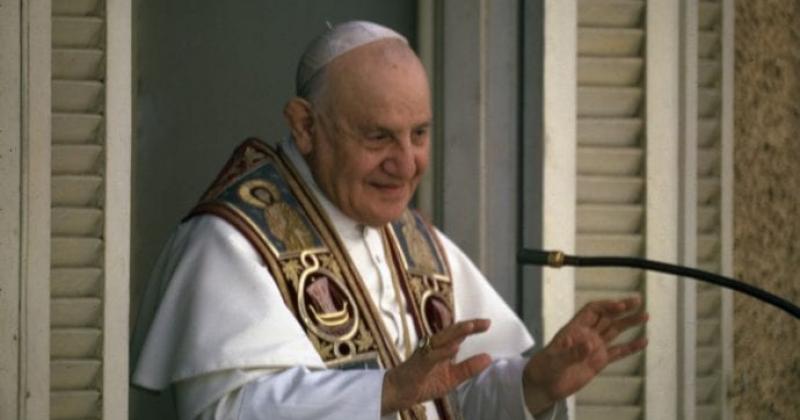In both the Catholic and Orthodox traditions, saints tend to play a major role in daily spiritual life, making it only fitting that when Pope Francis visits Bulgaria and Macedonia this weekend, shared devotion of several towering figures in Eastern Europe likely will emerge as a key theme.
In both nations, saints such as Cyril and Methodius, Mother Teresa and Pope John XXIII have long served as a point of unity for the small Catholic population and the vast Orthodox community.
Speaking to journalists at a May 3 briefing, interim Vatican spokesman Alessandro Gisotti said that in a conversation with Francis just a few days ago, the pontiff had specifically mentioned John XXIII and Mother Teresa, saying it’s important “to understand the good done by these people in these countries.”
In a May 3 video message to the people of Bulgaria, Francis praised the deep roots of Christianity in the nation, dating back to “the time in which the Saint brothers Cyril and Methodius sowed the Gospel there,” calling their work “a fruitful seed which has brought abundant fruits also in the difficult times of the past century.”
Cyril and Methodius were two brothers born in Greece in the mid-800s who, after becoming monks, were asked by the emperor at the time, Michael, to serve as missionaries, helping to expand Christianity in the Slavic world as he sought ecclesial independence.
Together, the brothers invented an alphabet and translated the Gospels, the psalms, the letters of Saint Paul and other liturgical books into the Slavonic language, and they composed a Slavonic liturgy.
Though the new liturgy was initially met with resistance, it was eventually approved by Pope Adrian II shortly before Cyril’s death in 869. Methodius continued his missionary work for another 16 years and was eventually named a bishop before his death in 884.
Though resistance to the brothers’ activities continued for years after their deaths, their spiritual, liturgical and cultural works spread throughout Bulgaria, Bohemia and southern Poland, and in 1985 they were honored by St. John Paul II in his encyclical Slavorum Apostoli, meaning “Apostles of the Slavs.”
Relations between Catholics and Orthodox in Bulgaria are occasionally marked by tension, mostly between the respective hierarchies, yet the brothers’ influence in both ecclesial communities is still distinctly felt. Catholics honor the brothers on Feb. 14, while the Orthodox community celebrates their feast May 11.
On the first day of his trip, immediately after meeting with Bulgarian president Rumen Radev and speaking with the nation’s diplomatic corps, Francis will pay a visit to the Holy Synod in Bulgaria, where he will meet with Bulgarian Orthodox Patriarch Neophyte.
He will then visit an Orthodox cathedral, where he will pray in front of the throne of Saints Cyril and Methodius.
Though more highly revered in the Catholic tradition, another saint whose influence on the pope’s visit to Bulgaria was enough to set the motto for the trip is Saint Pope John XXIII, who was canonized by Francis in 2014 and who served as an official in the papal embassy and later as the Vatican’s apostolic delegate in Bulgaria from 1925-1934.
The official theme for Francis’s trip to Bulgaria is Pacem in terris, which is the title of John XXIII’s historic encyclical dedicated to promoting the global pursuit of peace, justice and charity.
Affectionately known as the “Bulgarian pope,” John XXIII is highly respected in the country, and is revered as a pastor who cared deeply for his flock. He worked tirelessly to rebuild the church of Saint Michael the Archangel in Rakovsky, where Francis will celebrate Mass May 6 and administer First Communion to some 200 children, after it was leveled by an earthquake in 1988.
According to Gisotti, the pope’s gift to Radev will be a restored copy of the announcement of the then-Monsignor Angelo Giuseppe Roncalli as the Vatican’s ambassador to Bulgaria.
In his video message, Francis said his visit “will be entirely in the memory of Saint Pope John XXIII,” who during his time in Sofia “created with your people a bond of esteem and affection which endures to this day.”
The last day of Francis’s trip is a 10-hour stretch in Skopje, Macedonia, the birthplace of Saint Teresa of Calcutta. The visit, marking the first time a pope has traveled to Macedonia, will be almost entirely dedicated to the “saint of the gutters” and her spirit of charity, Gisotti said.
Born as Anjeze Gonxhe Bojaxhiu to Albanian parents in 1910 when the country still belonged to the Ottoman Empire, Mother Teresa died in 1997 after spending her life serving “the poorest of the poor” in the slums of India.
During his visit, Francis will stop at a shrine for Mother Teresa, where he will meet with poor persons cared for by the Missionaries of Charity order she founded. That stop will be attended by representatives from the five religious communities recognized in Macedonia’s constitution.
The memorial of Mother Teresa is located at church of the Sacred Heart, where she went as a child. In 1986 it was destroyed by an earthquake, and the shrine, which draws some 500,000 visitors a year, was later built to honor the saint.
On the fifth of each month a liturgy is held at Sacred Heart church in Skopje, which was Mother Teresa’s childhood parish, commemorating her death Sept. 5, 1997, which is also her feast day on the liturgical calendar, and which is marked every year by a series of events.
While there, Francis will bless the first stone of the shrine to be placed, and his gift to Macedonia President Gjorge Ivanov will be a canvas image of Mother Teresa.
